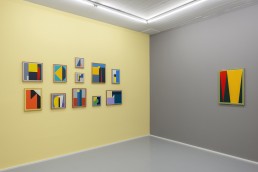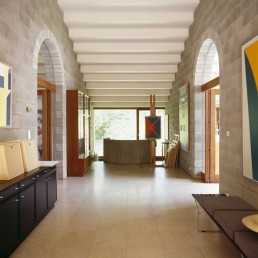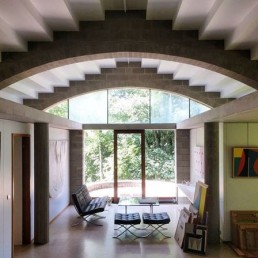Léon Wuidar, Inventaire
Rodolphe Janssen
9 September - 20 October, 2018
Livornostraat 32 and 35, 1050 Brussels, Belgium
In September of this year Léon Wuidar turned eighty years old, an occasion commemorated by a survey exhibition of his paintings at Galerie Rodolphe Janssen in Brussels. Exhibited regularly for 60 years in Belgium and in Europe, this exhibition is his third with Janssen, and, along with a recent project at White Cube in London, represents a relatively recent rediscovery of his art by a new generation of international collectors and artists.
Consisting of 34 canvases, within a size range traditionally referred to as easel painting in scale, the exhibition arrays one or two paintings from the late 1960s, during which time Wuidar formulated what could be described as his mature signature style, with a retrospective type sampling of works from subsequent decades. His paintings juxtapose geometric elements; squares, triangles, polygons and curvilnear components, most often executed in blocks of flat colour contiguous to each other, with the principal compositional components circumscribed at the perimeter by a double border of colours. Each is identically ‘finished’ in its object form by a modest frame, consisting simply of thin wood strips overlapped rather than mitred at the corners. Most works are titled simply with a date, suggesting that they are each a kind of memory repository known only to the artist, reflective of a personal experience that occurred on that day.

Wuidar has often cited post-war childhood memories of architectural ruin and stark military building in his home town of Liége as formative visual influences. Architecture more generally as a source of inspiration can be readily discerned in many of the works, especially those from the late 1960s and 1970s. Elements are reduced and stylised but nonetheless posit an obvious relational affinity to fenestration, architraves, pediments and the like, and consequently imply the dimensionality of built structures.

His relationship to architecture has been a career long leitmotif, collaborating on numerous occasions with the eminent Belgian architect Charles Vandenhove for whom he provided designs for both practical and decorative elements. The zenith of this collaboration might have been the 1976 design of his own home and studio. An archetypal Vandenhove design, the building also embodies many of the qualities of Wuidar’s work; modest and unpretentious, and with a clear functionalist rationale softened by a witty and elegant classical humanism. Wuidar continues to live and work there.


The title of the exhibition, Inventaire, comes from a prose poem written by Wuidar for the catalogue, the parataxis of which further illustrates the ordered logic by which Wuidar governs combinations of compositional elements. In the 1980s and 1990s his interest in the rhythm and meter of language preciptated numerous paintings featuring subtly stylised letter-elements, which in turn form hidden word compositions within the paintings. Humorous and playful, these works evolved into a highly graphic personal lexicon – a painter’s investigation into the structures of typographic forms.
Many of these motifs recur in the artist’s sketchbooks; used almost daily they are themselves a fascinating insight into Wuidar’s studious investigation of multiple permutations of a single overarching visual idea. The square compositional perimeter is drawn free hand in miniature, and then multiplied and deployed sequentially in row and column formation like a graphic alphabet. Each is a microcosm of his initial idea, showing various possibilities for, or versions of, the schema. Collectively they speak of a fastidious discipline, and further imbue the apparent hard-edge practice with a warmth and delicacy. Some, but not all, of these iterations are worked up into a painting.

In a general way Wuidar’s practice is affiliated with the tenets of concrete abstraction – traceable through an antecedent lineage including de Stijl and Bauhaus exemplars, and then through the kind of all encompassing modernist programme exemplified by Max Bill and his Allianz colleagues. Certainly Wuidar’s body of work embodies the kind of precise compositional and colouristic balance one would expect of these kinds of works, with repetition and seriality, flattening of perspectival space, mirroring and symmetry at the heart of his concerns. However, it would be erroneous to characterize the work as a purely dispassionate exercise in hard-edge dogmatism. Each painting has been rendered meticulously by hand, and upon close scrutiny this surety and deftness of human touch is always in evidence. The boundaries between the various colour-shapes and bands are never taped in production, but executed free hand. The evidence of such careful rendering is revealed by the whisps of almost microscopic brushstroke overlap one can see. Similarly, the blocked areas of solid colour are flat and opaque, layered to an irrefutable density, yet they are built by a seemingly infinite multitude of delicately stippled strokes, directionally consistent and uniform, and organic in their pattern like grasses in a field blown by a stiff breeze.
After such a long and quietly distinguished career it feels fitting that Wuidar’s work is brought to a new and ever increasing audience, and that the singular patience, wit and elegance of his paintings receives their deserved due. His works are serene, harmonious and carefully wrought exercises in both intellect and craft. They speak articulately of a machine age through their reductive but largely recognisable language of modernist signifiers, yet simultaneously they repudiate the machine through the diligent humility of their hand-made quality.

About the gallery
Rodolphe Janssen founded his gallery in Brussels in 1991, and has since organized over 200 exhibitions. The gallery participates in many major international art fairs, and in 2016-2017, it took part in Art Basel Miami, Armory, MiArt, Art Brussels, BRAFA, Art Düsseldorf and Frieze New York. At first, photography was Rodolphe Janssen’s main focus, but his scope has widened, and today he covers a number of disciplines and different generations of artists. During the twenty-six years since the gallery opened, he has built up strong relationships with collectors, contemporary art museums and art centres in Europe, the USA and Asia. Rodolphe Janssen is a member of the Belgian Chamber of Art Experts and of the selection committee of Art Brussels.
Website: rodolphejanssen.com
About the artist
Léon Wuidar (born in 1938 in Liège) lives and works in Esneux, Belgium. Recent solo exhibitions include White Cube, London (2018); Bibliotheca Wittockiana, Brussels, Belgium (2010); L’Espace du Dedans, Lille, France (2009) and Gesellschaft für Kunst und Gestaltung, Bonn, Germany (2007). Hiswork was also included in numerous group exhibitions including ‘L’abstraction géométrique belge’, Mouans-Sar- toux, France (2015); ‘Abstractions géométriques belges’, BAM, Mons, Belgium (2014); ‘Un siècle d’art abstrait’, Musée René Magritte, Brussels, Belgium (2010). His work is featured in numerous international public collections including Musée des Beaux-Arts, Brussels; Biblio- thèque Albertine, Brussels, Belgium; Fernmeldetechnisches Zentralamt, Darmstadt, Germany; Dorstener Maschin- enfabrik, Dorsten, Germany; and Fondation IDAC, Mondriaanhuis, Amersfoort, The Netherlands; Musée d’Art Wal- lon, Liège, Belgium; Cabinet des Estampes, Liège; Musée en plein air du Sart Tilman, Liège, Belgium; Centre de la Gravure et de l’image imprimée, La Louvière, Belgium; Fondation Meeus, Louvain-la-Neuve, Belgium; Musée de Mariemont, Morlanwelz, Belgium; Musée des Beaux-Arts, Verviers, Belgium.